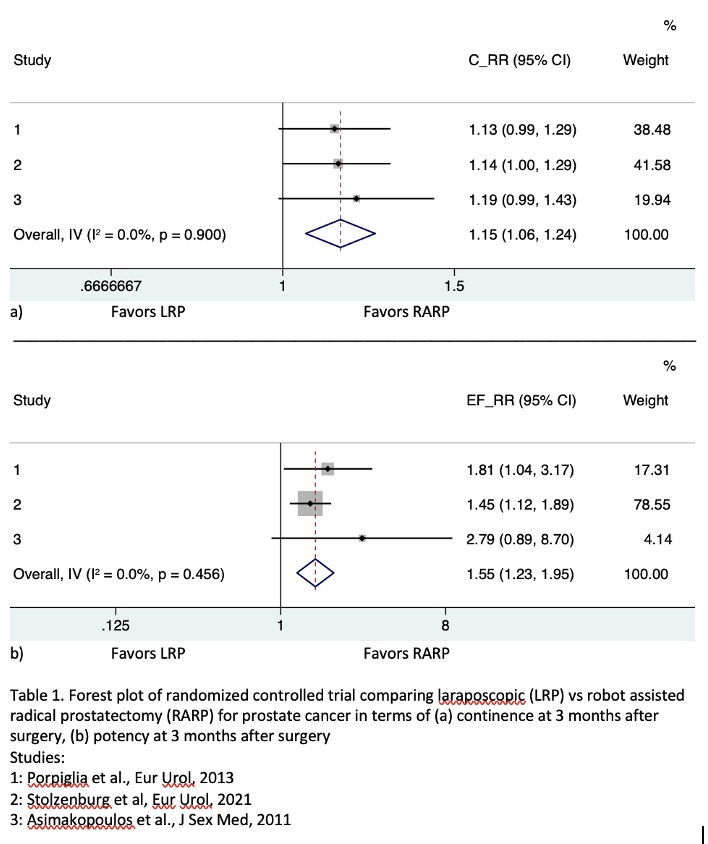Back
Introduction: We entered the third decade of the robotic era in prostate cancer (PCa) surgery, and robotic platforms are increasingly spreading worldwide. Robotic surgery is usually believed to facilitate critical steps of the prostatectomy, increasing the precision of the surgical act and optimizing the probability of favorable outcomes. However, strong evidence supporting superiority of robotic vs laparoscopic prostatectomy (LRP) in terms of functional results are still missing. We performed a systematic review (SR) and meta-analysis (MA) to assess the functional outcomes of LRP vs robot-assisted radical prostatectomy (RARP).
Methods: We searched for all the studies comparing LRP and RARP in Medline, Embase, the Cochrane Central Register of Controlled Trials, and abstracts from the AUA and EAU meetings up to October 2022. Results were independently reviewed by two authors following the PRISMA guidelines. A SR+MA were performed. We followed a predefined PICOS approach: (P) patients affected by PCa (I) LRP (C) RARP (O) continence and potency recovery and (S) randomized controlled trials (RCTs). Continence was defined as using no pads or one safety pad per day. Potency was defined either as IIEF-5 score >17 or capability of intercourse. Effect measures for the outcomes were relative risk (RR) and 95% CI. Random-effect models were utilized to report RR. The RoB 2 was used to assess the risk of bias.
Results: Three RCTs were included in this SR. A total of 966 patients undergoing RARP for localized PCa were included in the three studies. The number of patients undergoing LRP vs RARP was 60 vs 60, and 586 vs 196, and 64 vs 64 in the #1, #2 and #3 RCT, respectively. Continence recovery and erectile function (EF) at 3 months were the most reported outcomes. Across the three studies, the pooled RR for 3 months continence was 1.15 (1.06-1.24), while the pooled RR for 3 months EF was 1.55 (1.23-1.95), both in favor of robotic surgery (table 1). Therefore, we found a significant Risk of bias was assessed for all the three studies and determined as follows: “unclear risk of bias”.
Conclusions: This MA found a higher EF and urinary continence recovery rate in patients who underwent RARP vs LRP for localized PCa. Therefore, evidence from RCTs demonstrated that robotic surgery offers a significant advantage in terms of functional outcomes in these patients. SOURCE OF
Funding: None

Moderated Poster Session
Session: MP80: Prostate Cancer: Localized: Surgical Therapy IV
MP80-20: Functional Outcomes of Laparoscopic vs Robot-Assisted Radical Prostatectomy
Monday, May 1, 2023
1:00 PM – 3:00 PM CST
Location: S504
Poster Presenter(s)
Introduction: We entered the third decade of the robotic era in prostate cancer (PCa) surgery, and robotic platforms are increasingly spreading worldwide. Robotic surgery is usually believed to facilitate critical steps of the prostatectomy, increasing the precision of the surgical act and optimizing the probability of favorable outcomes. However, strong evidence supporting superiority of robotic vs laparoscopic prostatectomy (LRP) in terms of functional results are still missing. We performed a systematic review (SR) and meta-analysis (MA) to assess the functional outcomes of LRP vs robot-assisted radical prostatectomy (RARP).
Methods: We searched for all the studies comparing LRP and RARP in Medline, Embase, the Cochrane Central Register of Controlled Trials, and abstracts from the AUA and EAU meetings up to October 2022. Results were independently reviewed by two authors following the PRISMA guidelines. A SR+MA were performed. We followed a predefined PICOS approach: (P) patients affected by PCa (I) LRP (C) RARP (O) continence and potency recovery and (S) randomized controlled trials (RCTs). Continence was defined as using no pads or one safety pad per day. Potency was defined either as IIEF-5 score >17 or capability of intercourse. Effect measures for the outcomes were relative risk (RR) and 95% CI. Random-effect models were utilized to report RR. The RoB 2 was used to assess the risk of bias.
Results: Three RCTs were included in this SR. A total of 966 patients undergoing RARP for localized PCa were included in the three studies. The number of patients undergoing LRP vs RARP was 60 vs 60, and 586 vs 196, and 64 vs 64 in the #1, #2 and #3 RCT, respectively. Continence recovery and erectile function (EF) at 3 months were the most reported outcomes. Across the three studies, the pooled RR for 3 months continence was 1.15 (1.06-1.24), while the pooled RR for 3 months EF was 1.55 (1.23-1.95), both in favor of robotic surgery (table 1). Therefore, we found a significant Risk of bias was assessed for all the three studies and determined as follows: “unclear risk of bias”.
Conclusions: This MA found a higher EF and urinary continence recovery rate in patients who underwent RARP vs LRP for localized PCa. Therefore, evidence from RCTs demonstrated that robotic surgery offers a significant advantage in terms of functional outcomes in these patients. SOURCE OF
Funding: None


